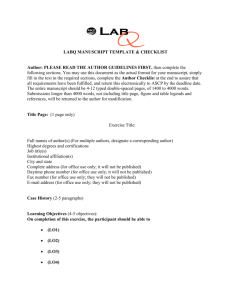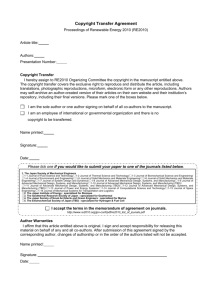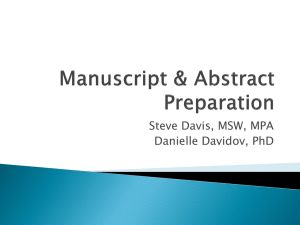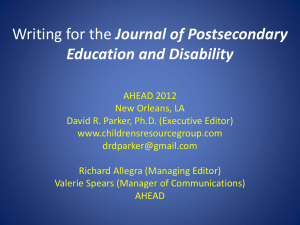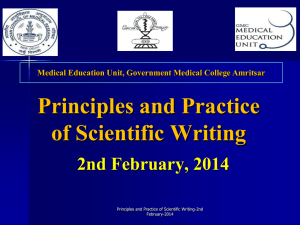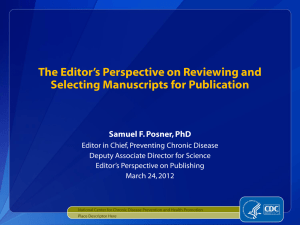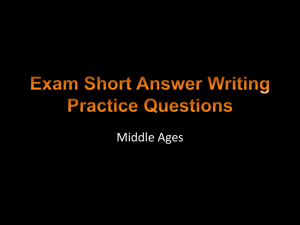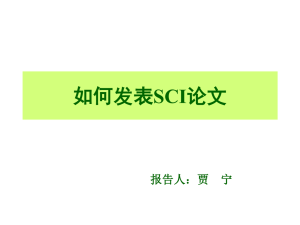INSTRUCTIONS TO THE AUTHORS:
advertisement
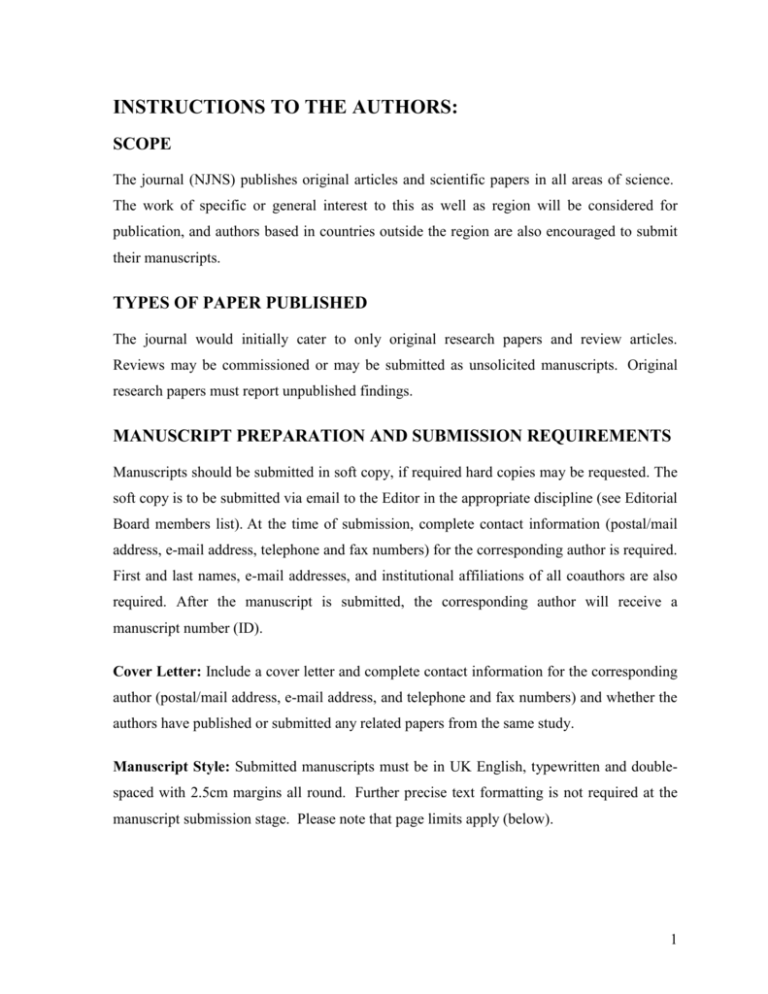
INSTRUCTIONS TO THE AUTHORS: SCOPE The journal (NJNS) publishes original articles and scientific papers in all areas of science. The work of specific or general interest to this as well as region will be considered for publication, and authors based in countries outside the region are also encouraged to submit their manuscripts. TYPES OF PAPER PUBLISHED The journal would initially cater to only original research papers and review articles. Reviews may be commissioned or may be submitted as unsolicited manuscripts. Original research papers must report unpublished findings. MANUSCRIPT PREPARATION AND SUBMISSION REQUIREMENTS Manuscripts should be submitted in soft copy, if required hard copies may be requested. The soft copy is to be submitted via email to the Editor in the appropriate discipline (see Editorial Board members list). At the time of submission, complete contact information (postal/mail address, e-mail address, telephone and fax numbers) for the corresponding author is required. First and last names, e-mail addresses, and institutional affiliations of all coauthors are also required. After the manuscript is submitted, the corresponding author will receive a manuscript number (ID). Cover Letter: Include a cover letter and complete contact information for the corresponding author (postal/mail address, e-mail address, and telephone and fax numbers) and whether the authors have published or submitted any related papers from the same study. Manuscript Style: Submitted manuscripts must be in UK English, typewritten and doublespaced with 2.5cm margins all round. Further precise text formatting is not required at the manuscript submission stage. Please note that page limits apply (below). 1 Manuscript Components: Include a title page, abstract, text, references, and as appropriate, figure legends, tables, and figures. Start each of these sections on a new page, numbered consecutively, beginning with the title page. Original research papers must adopt the following general structure: Title; Authors’ names and addresses (including e-mail); Abstract (not more than 250 words); Introduction; Methods; Results; Discussion; Conclusion and References. Review articles may adopt any reasonable structure suited to the subject covered, but must commence with an abstract. Short communications should be in the form of continuous text with a title but minimal headings. Recommended File Sizes: We recommend individual file sizes of no more than 500 kB and not exceeding 1 MB REVIEW AND REVISION After peer review, required revision and formal acceptance of papers, authors will be asked to prepare the final manuscript in camera-ready format (see below). Authors must then submit the camera-ready version and an electronic version on CD (if required), using Microsoft Word for Windows. CAMERA-READY FORMAT If an article is accepted by the Journal, authors are then responsible for preparing their manuscripts in camera-ready format. To be accepted for printing, the final version of manuscripts must be prepared following exactly these instructions for formatting: Manuscript File Formats. For submission and review, acceptable manuscript file formats include MS Word. Do not submit your manuscript in PDF format. Use 10-, 11-, or 12-point font size, double-space text, with right margins justified. Number the pages consecutively, with the first page containing: Title, Author(s), Affiliation(s), Full address for correspondence, including telephone and fax numbers and e-mail address. Abstract. Please provide a short abstract of 100 to 250 words. The abstract should not 2 contain any undefined abbreviations or unspecified references. The abstract should be typed as one paragraph. Key Words. Please provide a maximum of 6 key words or short phrases in alphabetical order, suitable for indexing. Abbreviations. Abbreviations and their explanations should be collected in a list, arranged alphabetically. Symbols and units. Only SI (Systeme International) units and abbreviations should be used. However, some quantities may be expressed in common units, e.g. mmHg. Abbreviations should be explained when they first appear in the text. If a non-standard abbreviation is to be used extensively, it should be defined in full on page 2 as mentioned above. BODY TEXT Font: Times New Roman, size 12 points. Page size: A4. Headings: block letters, Times New Roman, left justified, as follows: 1 Level One Heading: 14 points bold 1.1 Level Two Heading: 12 points bold 1.1.1 Level Three heading: 10 points bold Indents: the first line of new paragraphs should be indented by 5mm and should not be separated from preceding paragraphs by any blank line. Length of papers (camera-ready): no limit for review paper, normally 8 pages for research papers, 3 pages for short communications, 1 page for book reviews. TABLES Table headings should precede tables. Minimal use of vertical lines is preferable and formatting should be consistent across all tables. Tables that do not fit into 1 column width should be placed either at the beginning (before any text) or at the end (after all text) of the page in question, and can be justified across the entire page. 3 Horizontal lines are needed at the top and bottom of tables, and may also appear in the body of tables when clarity requires their use. FIGURES Number all figures (graphs, charts, photographs, and illustrations) in the order of their citation in the text. Include a title for each figure (a brief phrase, preferably no longer than 10 to 15 words). For initial manuscript submissions, figures must be of sufficient quality for editorial assessment and peer review. All illustrations, whether these are photographs, maps, graphs, diagrams, line drawings, etc. should be referred to as “Figures”. Figures must be submitted as separate files and not inserted in the document. Electronic figures must only be submitted as JPEG or TIFF files at high resolution, i.e. 500 dpi or greater. Other formats are not acceptable. If other programs were originally used for constructing charts, graphs or line diagrams (e.g. Excel, SPSS, Corel, Harvard Graphics), then each figure must be “exported” or “saved as” a JPEG or TIFF file. The journal does not print colored figures – high contrast grey tone figures only are accepted. Hardcopy submission: if figures are submitted as paper copies, then they must appear in black ink on white paper and must be of a high quality suitable for direct reproduction. Photographs should likewise be printed in black and white. Captions: figure numbers and captions must not be embedded in the figures. These should be provided in a separate list at the end of the text of the main manuscript. REFERENCES Authors are responsible for the accuracy and completeness of their references and for correct text citation. Number references in the order they appear in the text; do not alphabetize. Manuscripts must be adequately supported by reference citations. In the text, tables, and legends citations should be in the standard form of: Zann et al. (1990), or (Zann et al. 1990) 4 as appropriate. Multiple references should be separated by semi-colons, e.g. (Adams and Jones 1992; Masters 1993). The reference list should be ordered alphabetically and not contain blank lines. The style and format of the following examples should be adopted: Examples of reference style: Nunn PD. 1994. Oceanic Islands. Blackwell, Oxford, UK, 413pp. Terry JP. 1994. Soil loss from erosion plots of differing post-burn forest cover, Portugal. In: Soil Erosion as a Consequence of Forest Fires. Sala M and Rubio JL (Eds), Geoforma Ediciones, Logroño, Spain, 133-147. Akira S and Michal E. 2000. Roles of STAT3 defined by tissue-specific gene targeting. Oncogene, 19:2607-2611. Zann L, Brodie JE and Vuki V. 1990. History and dynamics of the crown-of-thorns starfish Acanthaster planci (L.) in the Suva area, Fiji. Coral Reefs, 9:135-144. ACKNOWLEDGMENT SECTION The “Acknowledgment section” is the general term for the list of contributions, credits, and other information included at the end of the text of a manuscript but before the references. The Acknowledgment section includes authors’ contributions; information on author access to data; disclosure of potential conflicts of interests, including financial interests and relationships; sources of funding and support; an explanation of the role of sponsor(s); information on independent statistical analysis (if required); names, degrees, and affiliations of participants in a large study or other group; any important disclaimers; information on previous presentation of the information reported in the manuscript; and the contributions, names, degrees, affiliations, and indication if compensation has been received for all persons who have made substantial contributions to the work but who are not authors. MANUSCRIPT CHECKLIST 1. Review manuscript submission requirements in these instructions 5 2. Include a cover letter as an attachment. 3. Designate a corresponding author and provide a complete postal/mail address, telephone and fax numbers, and e-mail address. 4. Provide first (given) and last (family) names, e-mail addresses, and institutional affiliations for any coauthors. 5. On the title page, include a word count for text only, exclusive of title, abstract, references, tables, and figure legends. 6. Provide an abstract that conforms to the required abstract format. 7. Double-space manuscript and leave right margins justified. 8. Check all references for accuracy and completeness. Put references in proper format in numerical order, making sure each is cited in sequence in the text. 9. Include a title for each table and figure (a brief, succinct phrase, preferably no longer than 10 to 15 words) and explanatory legend as needed. 10. Have each author read, complete, and sign the Authorship Form with statements of Authorship Responsibility, Criteria, and Contributions; Financial Disclosure and Funding/Support; and Copyright Transfer/Publishing Agreement. After submission, add the manuscript number to the top of each author form and send in the author forms by mail or fax to the editorial office. 11. Indicate specific contributions from each author in the Acknowledgment section at the end of the manuscript. 12. For reports of original data, include statement from at least 1 author that she or he “had full access to all of the data in the study and takes responsibility for the integrity of the data and the accuracy of the data analysis” in the Acknowledgment section at the end of the manuscript. 6 13. Include all authors’ potential conflicts of interest, including financial interests and relationships and affiliations relevant to the subject of their manuscript in the Acknowledgment section of the manuscript. 14. Include all sources of financial and material support and assistance along with detailed information on the roles of each sponsor or funder in each of the following: “design and conduct of the study; collection, management, analysis, and interpretation of the data; and preparation, review, or approval of the manuscript” in the Acknowledgment section of the manuscript. 15. In the Acknowledgment section of the manuscript, include the names, academic degrees, affiliations, and specific contributions of all persons who have contributed to the work reported in the manuscript (eg, data collection, analysis, writing or editing assistance, review of manuscript) but who do not fulfill authorship criteria, and also indicate whether any compensation was received for such contributions. 16. Include written permission from each individual identified as a source for personal communication or unpublished data. 17. The reproduction of material (including tables and figures) that was previously published is discouraged. Original material should be provided, except under extraordinary circumstances. 18. Include informed consent forms for identifiable patient descriptions, photographs, and pedigrees. PROOFS All manuscripts will undergo some editorial modification, so it is important to check proofs carefully. PDF page proofs will be sent via e-mail to the corresponding author for checking. To avoid delays in publication, proofs should be checked and returned within 48 hours. Corrections should be returned by annotated PDF, e-mail or fax. Extensive changes to the text may be charged to the author. 7 REPRINTS The journal does not provide reprints, but a free copy of the volume is sent to every contributor. SUBMISSION OF MANUSCRIPTS To accelerate the process of review, revision and acceptance/rejection, electronic submissions via e-mail is recommended. For the initial submission and for revision, please use A4 pages with double-spacing and wide margins. Submission as a Word document of pdf file is preferred. Papers are accepted twice a year (except for special edition) and will be included in volume(s) that will appear by in printed form. Since all papers will be posted online, the journal does not provide reprints. However, each author will receive a copy of the volume. Authors will be sent notifications of the receipt of manuscripts and editorial decisions by e-mail. EDITORIAL OFFICE CONTACT INFORMATION Cheif Editor: Dr. Attya Bhatti Associate Editors: Dr. Muhammad Qasim Hayat Dr. Amjad Ali Dr. Khalid Farooq ADDRESS: Editorial Office NUST journal of Natural Sciences (NJNS) Att-ur-Rahman School of Applied Biosciences (ASAB) National University of Sciences and Technology (NUST) H-12, Islamabad, Pakistan 44,000 Ph: +92 51 90856100 Fax: +92 51 9085 6102 For general enquires: For paper submission: njns@asab.nust.edu.pk njns.asab@gmail.com 8 Web: http://www.nust.edu.pk/INSTITUTIONS/Schools/ASAB/Research/Pages/NUSTJournal-of-Natural-Sciences-(NJNS).aspx 9


